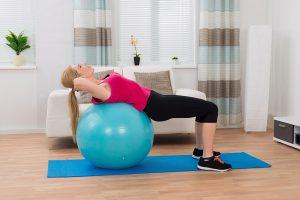Fitness trends come and go, but the age-old question of whether to commit to a gym membership or work out at home always remains. With the advent of programs such as CrossFit, many people believe that the only way to get a decent workout is with professional supervision and unconventional workouts. Working out at home is often seen as a temporary solution or a last ditch effort towards fitness. Here are some common myths that often deter people from home workouts and why they are wrong.
You need heavy machines and equipment to get a good workout
A common misconception regarding fitness is that the only way to get a solid workout is through the use of expensive and heavy equipment. While access to this equipment does have its perks and may be necessary for certain fitness goals, most desired results can be achieved through more economic means. Initially, working out at home requires no investment besides your time. Most fitness routines focus on something called strength training, which relies on resistance to exercise the muscles. Traditionally, this “resistance” is applied through the aforementioned gym equipment. However, this is not the only method. Resistance can be achieved by other means such as workout bands, medicine balls, kettlebells, or even through your own bodyweight. A simple online search of “at-home bodyweight workouts” turns out a range of interesting and diverse workouts that can be completed at little to no cost in the comfort of your own home. As you grow in your fitness journey and your goals change, you can begin to purchase equipment to meet those needs.
Cardio and home workouts do not mix
Cardio is a cornerstone of every fitness routine. Whether you love it or love to hate it, cardio is important. Working out at home means working out in a more confined space, and, unless you own a treadmill, running may not be your main source of cardio. Luckily, not only are there alternatives to running that you can do in your own home, but these alternatives are also often less time-consuming and notably more effective. Instead of spending an hour or two running at a steady pace, many fitness experts suggest alternating small intervals of high intensity training. This technique forces the heart into different levels of exertion and forces the body to work more efficiently to deliver oxygen to tired muscles. It also creates an afterburn effect so that you continue to burn calories even after you have finished the workout. This method, often referred to as “HIIT,” utilizes a variety of different workouts with interspersed periods of rest. Typically, these workouts last no longer than an hour and can be used for solely cardio purposes or can be combined with more traditional strength training exercises for a more complete workout.
Home workouts are boring
Working out at home does not mean cycling between the same three fitness videos for weeks on end. Many people become discouraged with at-home workouts because they quickly become bored and lose motivation. With countless online forums and fitness articles available, however, the possibilities for workout routines are endless. Not only is it possible to find lists of movements that exercise specific parts of the body, but there are also often pictures or videos attached that clearly illustrate how to complete the movements. Creating a workout schedule which clearly outlines which muscle groups to work out on specific days makes it easy to compile an arsenal of routines that can be interchanged weekly. Above all else, it is important to remember that working out at home provides you with the freedom to work at your own pace and learn as you go.
Home workouts are too long (or too short)
Far too often, the results of a workout are estimated by the length of a gym visit. Intuitively, it would make sense that a two-hour workout would yield more results than a one-hour workout. It is important to take into account, however, that the length of a gym visit can vary drastically due to external forces. During hours of heavy traffic, gym-goers can expect to tack on an extra thirty minutes or more to a workout simply because it takes time to wait for a machine to become available. When gyms are ill-equipped and multiple people are waiting on the same machine, it can force a person to change integral parts of a workout just to save some time. At home, the only person dictating the pace of the workout is the person participating in said workout. Whether it be a thirty-minute high-intensity circuit workout or a relaxed two-hour yoga session, the participant gets to make all the decisions. Freedom from scrutiny and outside pressures allows people of all fitness levels to experiment with their workouts and find out what suits them. For some, a quick and intense workout six days a week is what produces results. Others may prefer longer routines but choose to only work out four days a week. Time is relative!
I do not have the space to work out at home
If you have enough space to do a push-up, a squat, and a jumping-jack, you have enough space to work out. An entire room dedicated solely for the purpose of working out is often not feasible and completely unnecessary. The area between your couch and TV, the length of your hallway, or even an empty space in your bedroom is fair game. It does not take much space to work out at home, only creativity. Making the most of what is available to you is crucial for at-home workouts. Instead of seeing a bulky couch taking up room, view it instead as a solid foundation on which to do dips. Have a set of steps by your front door? Capitalize on the structure of your home and use them for side step-ups or toe taps. Equipment such as yoga mats and resistance bands are small, easy to store, and make all the difference in turning your living room space into your very own personal gym.
Katerin Rodriguez
Home & Yard Magazine





